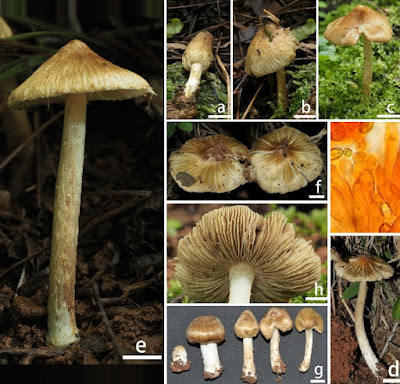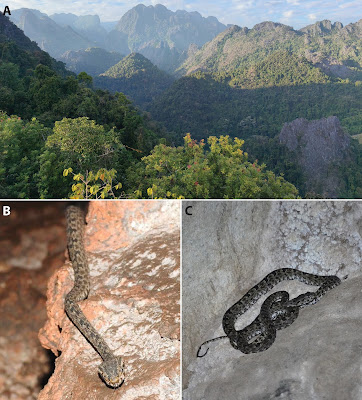[Most Recent Entries] [Calendar View]
Wednesday, February 26th, 2025
| Time | Event | ||||
| 7:44a | [Botany • 2020] Primulina spiradiclioides (Gesneriaceae) • A New Species from limestone areas in Guangxi, China Abstract Primulina spiradiclioides Z.B. Xin & F. Wen (Gesneriaceae), a new species from limestone areas in Guangxi, China, is described and illustrated. It resembles P. curvituba, but can be easily distinguished from it by several characters, especially by its straight corolla tube. We found only one population with fewer than 200 mature individuals at the type locality. Primulina spiradiclioides Z.B. Xin & F. Wen Zi-Bing Xin, Zhang-Jie Huang, Long-Fei Fu, Shu Li, Bing-Mou Wang and Fang Wen. 2020. Primulina spiradiclioides (Gesneriaceae), a New Species from Limestone Areas in Guangxi, China. Annales Botanici Fennici. 57(4-6); 245-248. DOI: doi.org/10.5735/085.057.0408 [28 October 2020] | ||||
| 8:34a | [Funga • 2020] Pseudosperma citrinostipes (Agaricomycetes: Inocybaceae) • A New Species associated with Keteleeria from southwestern China
Abstract Pseudosperma citrinostipes sp. nov. from southwestern China is described and illustrated based on morphological, ecological, and molecular data. The new species is characterized by a medium-sized slender habit, straw yellow to golden yellow pileus, crowded lamellae without olive tinges, an equal stipe with lemon yellow to golden fibrils, large ellipsoid to subphaseoliform basidiospores, subfusiform to lageniform cheilocystidia, and the presence of caulocystidia at the stipe apex. Phylogenetically, P. citrinostipes is placed in the P. rimosum complex and is sister to the rest of the taxa of the species complex. Keywords: Agaricomycetes, cryptic species, taxonomy, Yunnan province
Pseudosperma citrinostipes sp. nov. Wen-Jie YU, Cheng CHANG, Li-Wu QIN, Nian-Kai ZENG, Shao-Xian WANG and Yu-Guang FAN. 2020. Pseudosperma citrinostipes (Inocybaceae), A New Species associated with Keteleeria from southwestern China. Phytotaxa. 450(1); 8-16. DOI: doi.org/10.11646/phytotaxa.450.1.2 | ||||
| 9:56a | [Botany • 2022] Epidendrum dayseae (Orchidaceae: Laeliinae) • A New Species from northern Brazil. Abstract A new Epidendrum species of the Nocturnum group is proposed for the Brazilian central Amazon, near Manaus. It is described, illustrated, and compared with similar species. Epidendrum dayseae can be recognized by the pendent stem, the long, narrow leaves, a relatively long floral pedicel, and the lateral lobes of the lip smaller than the mid-lobe and deeply separated. The new species resembles E. longicolle, but is distinguished by the union between of the lateral and mid-lobes of the lip being under half the mid-lobe length. The new species is also compared with E. plurifolionocturnum. Its chromosome number is 2n = 4x = 80, with a band pattern similar to other species of the Nocturnum group. Brazilian Amazon, campina/campinarana, epiphytic, Laeliinae, taxonomy, Monocots Amauri H. Krahl, Joel M. P. Cordeiro and Eric Hágsater. 2022. Epidendrum dayseae, A New Species of Orchidaceae (Laeliinae) from northern Brazil. Phytotaxa. 530(1);95-102. DOI: doi.org/10.11646/phytotaxa.530.1.8 | ||||
| 10:12a | [Botany • 2019] Agapetes yingjiangensis (Ericaceae) • A New epiphytic Species from Yunnan, China
Abstract Agapetes yingjiangensis (Ericaceae), a new species from Yingjiang County, Yunnan Province, China is described and illustrated. This new species is somewhat similar to A. mannii Hemsl., but differs in having brown-hirsute young branches, acute mucronate apex of the leaf blade and sparsely hirsute pedicel, calyx tube and corolla. A key to Chinese species with small (less than 2.5 cm) entire leaves in Agapetes sect. Agapetes ser. Longifiles is included.
Agapetes yingjiangensis Y.H.Tong, B.M.Wang & N.H.Xia Yi-Hua Tong, Bing-Mou Wang and Nianhe Xia. 2019. Agapetes yingjiangensis (Ericaceae), A New epiphytic Species of A . ser. Longifiles from Yunnan, China. Nordic Journal of Botany. 37(1); e02171. DOI: doi.org/10.1111/njb.02171 | ||||
| 3:17p | [Botany • 2025] Piper kiminensis (Piperaceae) • A New Species with shingling variegated leaves from Arunachal Pradesh, India Abstract Piper kiminensis (Piperaceae), a new species, is described from Arunachal Pradesh, northeastern India, along with notes on its habitat, ecology, and conservation status. A dioecious, semi-woody climber with distinct dimorphic branches, it is distinguished from other climbing pipers by its vegetative branches possessing shingled, variegated leaves. The new species does share some similarities with P. obtusissimum in its vegetative branches and P. betleoides in its fertile branches, so a table with detailed morphological features for all three species is provided for easy comparison. For aid in recognition, color photographs are also included. The molecular studies based on the ITS sequence also confirmed the distinctness of the new species from other taxa. Moreover, it shows little similarity with any of the existing Piper species. Conservation, Critically Endangered, Dioecious, Kimin, Papum Pare, Taxonomy, molecular phylogeny, Magnoliids Piper kiminensis sp. nov. Padma Raj GAJUREL, Tage YAKANG, Soyala KASHUNG and Dipankar BORAH. 2025. Piper kiminensis (Piperaceae) A New Species with shingling variegated leaves from Arunachal Pradesh, India. Phytotaxa. 689(2); 269-276. DOI: doi.lorg/10.11646/phytotaxa.689.2.10 [2025-02-24] | ||||
| 4:16p | [Herpetology • 2025] Protobothrops flavirostris • A New endemic Karst-associated Species of Lance-headed Pit Viper (Serpentes: Viperidae: Protobothrops) from Laos
Abstract We describe a new species of lance-headed pit viper from north-western Laos, based on morphological and molecular (6092 bp from cyt b, ND4, COI, 12S rRNA and 16S rRNA mitochondrial DNA genes and c-mos and RAG1 nuclear DNA genes) lines of evidence. Protobothrops flavirostris sp. nov. is easily distinguished from its congeners by the following combination of morphological characters: dorsal scales in 23–21–17 rows, all keeled; ventral scales 215; subcaudal scales 79, all paired; supralabials 7–8; infralabials 10; horn-like projections on supraoculars absent; head triangular with a typical lance-shaped pattern on its dorsal surface; three faint dark vertical stripes on the snout; head blackish-brown with rostral, nasals, preoculars, loreals and the two anterior supralabials, as well as the anterior parts of supraoculars yellow-orange; dorsal surfaces of body and tail brown or greyish-brown, dorsum with large dark reddish-brown cross-shaped blotches, edged in black, somewhat fused together forming an interrupted zigzag line and a row of large brown ventrolateral blotches on each side. The new species differs from the morphologically similar species Protobothrops kelomohy by a significant divergence in cytochrome b mitochondrial DNA gene sequences (p = 7.8%). The new species is currently known only from tropical limestone forest of Vientiane Province, north-western Laos (elevation 362 m a.s.l.). We suggest the new species be considered as Endangered (EN) following the IUCN’s Red List categories. Key Words: Indochina, limestone, morphology, molecular phylogeny, Protobothrops flavirostris sp. nov., systematics, Vientiane Province Family Viperidae Oppel, 1811 Subfamily Crotalinae Oppel, 1811 Genus Protobothrops Hoge & Romano-Hoge, 1983
Protobothrops flavirostris sp. nov. Diagnosis. The new species Protobothrops flavirostris sp. nov. differs from other members of the genus Protobothrops by the following combination of the morphological characters: dorsal scales in 23–21–17 rows, all keeled; ventral scales 215; subcaudal scales 79, all paired; supralabials 7–8; infralabials 10; horn-like projection on supraocular absent; head triangular with a typical lance-shaped pattern on dorsal surface; three faint dark vertical stripes on snout; head blackish-brown with rostral, nasals, preoculars, loreals and the two anterior supralabials, as well as the anterior parts of supraoculars yellow-orange; dorsal surfaces of body and tail brown or greyish-brown, dorsum with large dark reddish-brown cross-shaped blotches, edged with black, somewhat fused together forming an interrupted zigzag line; and a row of large brown ventrolateral blotches on each side. Etymology. The specific name “flavirostris” is a Latin adjective in the nominative singular, masculine gender, derived from Latin words “flāvus” for “yellow” and “rostrum” for “snout” or “beak” and is given in reference to the characteristic yellowish colouration of the snout in the new species. We suggest the following common names for the new species: “Vang Vieng lance-headed pit viper” (in English), “Ngu Phao Ka Ba Khor Kop” (“ງູເພົາກະບາຄໍກົບ”, in Lao) and “Laosskiy habu” (“Лаосский хабу”, in Russian). Furthermore, the new species is well-known to the Hmong people living in village communities around Vang Vieng and their local name for this species is “nan jaow ka,” which is roughly translated as “a snake that can open its mouth very wide” or “big-mouthed snake”. Rupert J. Grassby-Lewis, Peter Brakels, Nathanaël Maury, Saly Sitthivong, David Frohlich, Parinya Pawangkhanant, Sabira S. Idiiatullina, Tan Van Nguyen and Nikolay A. Poyarkov. 2025. A New endemic Karst-associated Species of Lance-headed Pit Viper (Squamata, Viperidae, Protobothrops) from Laos. Herpetozoa. 38: 43-60. DOI: doi.org/10.3897/herpetozoa.38.e146004 |
| << Previous Day |
2025/02/26 [Calendar] |
Next Day >> |















